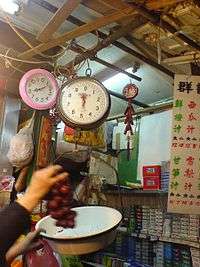Hong Kong units of measurement
Hong Kong has three main systems of units of measurement in current use:
- The Chinese units of measurement of the Qing Empire (no longer in widespread use in mainland China);
- British Imperial units; and
- The metric system.

In 1976 the Hong Kong Government started the conversion to the metric system, and as of 2012 measurements for government purposes, such as road signs, are almost always in metric units. However, all three systems are officially permitted for trade,[1] and in the wider society a mixture of all three systems prevails.
Length
The Chinese system's most commonly used units were 里 (li), 丈 (tseung/cheung), 尺 (tsek/chek), 寸 (tsun/chun), 分 (fen/fan) in descending scale order. These units are now rarely used in daily life, the Imperial and metric systems being preferred.
The Imperial system's units are written with the same basic Chinese characters as the Chinese system. In order to distinguish between the units of the two systems, the units can be prefixed with ying (Chinese: 英) for the British Imperial system and wa (Chinese: 華) for the Chinese system. In writing, derived characters are often used, with an additional 口 radical to the left of the original Chinese character, for writing Imperial units. The most commonly used units are the mile or li (Chinese: 哩), the yard or ma (Chinese: 碼), the foot or chek (Chinese: 呎), and the inch or tsun (Chinese: 吋).
Weight
Chinese, Imperial and metric weight units are all used in Hong Kong. The choice of system depends on the type of goods and their origins. Metric is used for all official purposes, for example the Post Office and Road signs.[2][3] Packaged food weights and volumes may be given using any of the three systems of units.[4]
Traditional weights are still de facto standard in certain areas. For example, vegetables, meats, and Chinese medicines are usually measured in Chinese units, while some fruits are normally measured using the Imperial system.
Precious metals (gold, silver and platinum) are traded in the Chinese troy weight system, which differs from other goods.
Area
The traditional measure of flat area is in square feet (Chinese: 方呎, 平方呎) of the Imperial system. Apartment or office size is generally still given in square feet. Traditionally, the measurement of agricultural plots and fields are conducted in 畝 (mau) of the Chinese system.
Volume
In Chinese system, the measurement of volume of rice is 斗 (dau) but it is replaced by packaged rice in weight. The volume of water and fuel is the litre. The gallon (加侖, ga-lun) of the Imperial system is still occasionally used.
Time
Time measurement follows the international system. Gregorian calendar is usually used, but the Chinese calendar also plays a very important role in everyday life and in telling the dates of traditional festivals.
In the following table, multiple Chinese names are listed in the order of usage frequency.
| English name | Chinese name | Cantonese pronunciation | Equivalent in other units | Notes |
|---|---|---|---|---|
| Year (Gregorian) | 年 | nin4 | 365 or 366 days | Roughly follows a solar cycle. Historically, the Chinese refer to the return of the Sun in the winter solstice as "歲" (seui3). |
| Year (Chinese) | 年 | nin4 | 12 or 13 Chinese months | In Chinese years with 13 months, the 13th month is known as the intercalary month. |
| Month (Gregorian) | 月 | yut6 | 28, 29, 30 or 31 days | The Gregorian month lost the meaning of the lunar cycle. |
| Month (Chinese) | 月 | yut6 | 29 or 30 days | Roughly in sync with the lunar cycle |
| Day | 日 | yat6 | 24 hours | |
| Hour | 鐘 / 鐘頭 / 小時 | jung1 / jung1-tau4 / siu2-si4 | 4 quarters or 60 minutes | "鐘" also means "clock" or "bell", which usually chimes every hour. |
| Quarter | 骨 | gwat1 | 15 minutes | "骨" is the Cantonese loanword for "quarter". |
| 字 | ji6 | 5 minutes | "字" is very commonly used in colloquial speech, more so than "分鐘". | |
| Minute | 分鐘 / 分 | fan1-jung1 / fan1 | 60 seconds | |
| Second | 秒 | miu5 |
Energy
The kilojoule or kilocalorie is the unit used for the measurement of energy in food. The British thermal unit (BTU) is still used to measure the output of air conditioners.
Power
Horsepower (馬力) is still the dominant measurement for the power of cars . The Chinese counting word 匹 (pat) is the measure word in Chinese, carried over from the measure word of horses.
See also
- Units, Systems, & History of measurement
- Chinese & Taiwanese units of measurement
- Japanese, Korean, & Vietnamese units of measurement
- English, Imperial, & US units of measurement